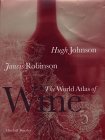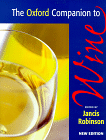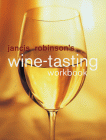 My top 10
Browse by author
Browse by category
The full list
|
| The wine bookshop Jancis Robinson |
| Please note I haven't listed any prices
here. This is because the links will take you to the relevant entry in the amazon.co.uk
catalogue, which will give the up-to-date price (usually substantially discounted): this
may change at short notice. |

The
World Atlas of Wine
Hugh Johnson, Jancis Robinson
Hardcover - 352 pages 5th Ed (1 September,
2001)
Mitchell Beazley; ISBN: 1840003324
Reviews
Synopsis
There are few books that have had such a monumental impact in their field
as The World Atlas of Wine; sales of the first four editions exceed 3.5
million copies. Now, world-renowned authors Hugh Johnson and Jancis
Robinson have teamed up to combine their unrivalled talents. Together they
have created the fifth edition of this masterpiece, making it the most
thorough and expansive revision ever of the work. In keeping with the
Atlas's reputation for cartographic excellence, all 148 maps from the
fourth edition have been completely revised and modernised, with an
additional 30 new maps. Hailed by Decanter as Wine Book of the Millennium,
The World Atlas of Wine has been described by critics worldwide as
'extraordinary' and 'irreplaceable'. In this, its fifth edition in 30
years, it remains an essential addition to every wine-lovers or
professional's library.
Go
to the amazon.co.uk catalogue entry for this book
 Confessions of a Wine Lover Confessions of a Wine Lover
Jancis Robinson
Paperback - 384 pages ( 5 November, 1998)
Penguin Books; ISBN: 0140235299
Reviews
wineanorak.com
I have to declare from the outset that from the moment I
picked up this book I couldn't put it down again, and I was desperately sorry when I
finished it. Jancis shares the story so far of her involvement in the wine trade,
progressing from a newsletter editor to her current status as media darling and one of the
most universally respected of all wine journalists. It is a beautifully written book, and
is likely to prove utterly engrossing for any reader who has been bitten by the wine bug.
Jancis scores very highly for getting the balance right between the old and the new. She
has a healthy respect for traditions without taking cheap potshots at new developments,
and she is a populizer without being a vulgarizer. She proves that it is possible to drink
the world's finest without becoming a snob. Best of all she embraces change as a friend
rather than treating it as an enemy. As for those who question whether she should be
writing her autobiography at all, my response would be that as she has been in the wine
trade since the 70s, and she has witnessed a major period of fundamental change over the
last 25 years, which she chronicles beautifully. Put this book at the top of your shopping
lists.
Buy this book from amazon.co.uk
 Jancis
Robinson's Concise Wine Companion Jancis
Robinson's Concise Wine Companion
Jancis Robinson
Paperback - 640 pages (31 March, 2001)
Oxford University Press; ISBN: 0198662742
Review
www.wineanorak.com
Most wine geeks will be familiar with the Oxford Companion to Wine, the
second edition of which was released back in 1999. Along with Hugh Johnson's
Wine Atlas, this is one of the classic texts that should be on every wine
lover's bookshelf. Well, the concise wine companion has some 2350 of the
entries from the Oxford Companion included in its 559 pages, and from
leafing through the entries it's hard to see what's missing -- there are no
noticeable omissions (the preface mentions that only two subject areas --
distilled and fortified wine -- that have been omitted or substantially
cut). The cross-referenced entries are well enough written, in a
semi-formal, economical and precise 'lexicographer-speak' language to make
casual browsing worthwhile. Maybe I'm an unredeemable anorak, but I spent a
happy couple of hours just reading from one entry to another. So, if you
already possess the Oxford Companion, should you purchase this book? I'd say
yes, for one key reason -- portability. You can fit this book in your
briefcase or find space for it on your desktop, whereas its hardback
predecessor is an unwieldy doorstop of a book. If you don't already have a
copy of the Oxford Companion, then the decision to buy this is a bit of a
no-brainer, especially when Amazon are retailing it for a penny less than £8.
Faults? Well, the cover design looks a bit 1970s: it is split vertically,
with a weakly smiling, slightly embarrassed-looking editor on one side and
the obligatory wine glass shot on the other. But we can forgive this,
because this is such a useful, well-written book.
Go
to the amazon.co.uk catalogue entry for this book
 Jancis Robinson's Wine Course Jancis Robinson's Wine Course
Jancis Robinson
Paperback -
320 pages ( 2 September, 1999)
BBC Consumer Publishing (Books); ISBN: 0563551313
Reviews
wineanorak.com
Intended as a companion to the BBC TV series,
this book actually has little in common with the programmes, which were Jancis'
imaginitive and personal snapshots of the different grape varieties, each episode focusing
on a different grape by looking at the region that achieves the best with that variety.
Instead, the book is a comprehensive introductory wine course that gives the wine novice a
thorough grounding in the basics. If this all sounds a little dry, it isn't—Jancis in
print is much as she is on telly; witty, sophisticated and eloquent. However, to anyone
who has read around the subject of wine a bit, the book covers a lot of familiar ground.
An ideal starting point in your reading about wine.
Book Information
Based on her wealth of knowledge and experience, Jancis Robinson helps you choose the
right bottle of wine from the huge range available today. In acomprehensive guide to the
wine-producing countries of the world, she captures the flavour of each region's wines and
gives her own recommendations for the best names to look out for. To make selection even
easier, she describes the distinctive characteristics of hundreds of different grape
varieties.
Designed to ensure that you get the most out of every glass, Jancis Robinson's Wine
Course covers everything from how to taste and store wine, to deciding what to serve
on special occasions, and the best-value bottles to order in restaurants. With an updated
vintage guide including the best regions in 1998, choosing your wine has never been more
interesting and enjoyable.
"She has an encylclopedic grasp of her subject and doesn't put a foot wrong ... a
splendid introduction to the world of wine..." -- Stephen Brook, Decanter Magazine
Buy this book from amazon.co.uk
 The Oxford Companion
to Wine The Oxford Companion
to Wine
Jancis Robinson (Editor)
Hardcover - 848 pages (21 October, 1999)
Oxford University Press; ISBN: 019866236X
Reviews
wineanorak.com
(Review of the first edition.) The ultimate wine
reference book. Editor Jancis Robinson has called on a large team of some of the most
knowledgable wine experts from around the globe to produce over 3000 alphabetically
arranged entries covering all manner of wine-related topics. These entries are nicely laid
out in a substantial (and weighty) book, which is nicely illustrated by a mixture of
line drawings, black and white photographs and a few colour plates. Comprehensive and
scholarly, yet at the same time readable enough for leisurely browsing. This is a
compulsory purchase for anyone who has a serious interest in wine. The big question for
those who own a copy of the first edition is whether it is worth splashing out on the
newly released second edition, which has been substantially revised
Amazon.co.uk
Wine head girl Jancis Robinson publishes a new edition of her acclaimed Oxford
Companion to Wine, coming as close as anybody is likely to in achieving the
unachievable goal of a detailed, comprehensive, single-volume work of reference covering
the whole world of wines. Just how daunting the task of keeping up with the now
practically supersonic pace of development in many areas of the wine industry must be is
indicated by the need, only five years after the first edition, to issue another with
updated versions of about half the 3,000 entries. It is an awesome achievement. Wine is
now a modern, global industry: Jancis Robinson and her team of contributors require--and
deliver--expertise in a really astonishing range of disciplines.
Practically every field of human knowledge seems to have something
to contribute. From geology and soil chemistry, through forestry and the nature of the
different woods used for barrels and the harvesting of cork bark, to the cultivation of
the vine, its training and pruning, and the techniques of fermentation; the list extends
even into areas of cutting-edge science such as DNA fingerprinting (which finally in 1997
unravelled the mystery of the parentage of the Cabernet Sauvignon grape--no, wild horses
wouldn't drag it from me, you'll have to buy the book). This is not to mention the
thorough coverage of wine regions and grape varieties, the role of wine through history
and its presence in art, the glossary entries. One could go on and on. This is a
stupendous feat of organisation. More than that, it is throughout well written and lively,
and in possession of a healthy quantity of attitude. --Robin Davidson
Buy this book from amazon.co.uk
 Jancis Robinson's
Guide to Wine Grapes Jancis Robinson's
Guide to Wine Grapes
Jancis Robinson
Paperback - 234 pages (14 October, 1996)
Oxford University Press; ISBN: 0198662327
Synopsis
Grape names and characteristics have never been so important for wine producers and
consumers. An increasing proportion of wines are labelled with the names of the grape
variety or varieties that go into them. They can provide vital clues for the wine drinker
to the likely flavour and characteristics of the liquid inside the bottle. A handful of
varieties - Chardonnay, Cabernet Sauvignon, Pinot Noir, Sauvignon Blanc and so on - are
grown in almost every wine region so that understanding them provides a fast track to
understanding a significant proportion of all wine produced in the world today. But
producers and consumers are tiring of this domination so that the range of grapes
trumpeted on labels is broadening. This book, with more than 800 grape names listed and
hundreds of different varieties described, provides a guide to an increasingly important
aspect of wine appreciation.
Buy this
book from amazon.co.uk
 Jancis Robinson's
Wine-tasting Workbook Jancis Robinson's
Wine-tasting Workbook
Jancis Robinson
Hardcover - 208 pages (19 October, 2000)
Conran Octopus; ISBN: 1840911395
Synopsis
This guide to wine-tasting combines practical instruction with space for writing your own
tasting notes. There is advice on how to record sensations and experiences, how to serve
and store wine, and what to expect from wine-tasting sessions.
Reviews
www.wineanorak.com
What a shame about the title. The word 'workbook' conjures up
images of education, schoolrooms, homework and swotting for exams. For most people, these
aren't images of fun, and it would be a shame if people are put off what is an excellent
book by simple word association.
I usually find 'introduction to wine' books yawn-inducingly
dull, but this is different. Jancis strikes the balance right between imparting essential
information and keeping the book lively and fun, without falling into the trap of dumbing
down or forced jokiness. There's all the usual material that these sort of books usually
have, but with a fresh twist. Best of all, this book is intensely practical in its nature:
the focus is on actually drinking the stuff (an indication of this is given by the title
of the foreword: 'A book for the thirsty'). I can't help feeling that this is healthy and
appropriate for a book about wine. One of the most effective features is that Jancis has
divided the text is divided into sections on both theory and practice, and it’s the
latter components that set this book apart from the competition. While any old hack can
write about wine theory, it is a whole lot more difficult to write successfully and
sensibly about the practical side of wine tasting, and this is done here very well. A
further useful feature is the glossary of wine tasting words, which are sensibly and
accessibly described.
Although this is clearly targeted at the novice wine geek -- for whom I'd say this was
pretty much compulsory reading -- I think it has a lot to offer the more serious wine nut.
I found it a really good read, and for me it helped provide a nice balancing perspective.
Let's face it, there's an awful lot written about wine, but not a great deal about how it
actually tastes, and this is surely what counts. Wine is a complex subject -- and to
someone new to wine this complexity can seem bewildering. So if you are starting out on
the road to wine geekdom, I can think of no better book to guide you on your way.
Buy this
book from amazon.co.uk
|


 Confessions of a Wine Lover
Confessions of a Wine Lover
 Jancis Robinson's Wine Course
Jancis Robinson's Wine Course The Oxford Companion
to Wine
The Oxford Companion
to Wine Jancis Robinson's
Guide to Wine Grapes
Jancis Robinson's
Guide to Wine Grapes Jancis Robinson's
Wine-tasting Workbook
Jancis Robinson's
Wine-tasting Workbook